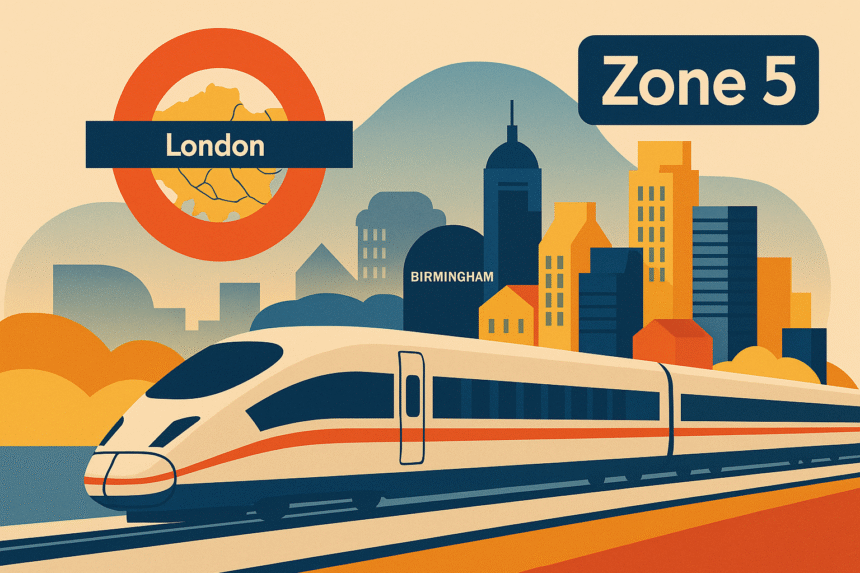Birmingham is seeking to redefine its economic and geographic identity as the long-delayed High-Speed 2 (HS2) rail project edges closer to reality. At a government-backed regional investment summit this week, local officials and investors portrayed the project as a transformative development that could effectively place the UK’s second-largest city within London’s commuter orbit.
A “Zone 5” Future
West Midlands Mayor Richard Parker highlighted the scale of change HS2 promises, telling delegates:
“Thanks to HS2, this region will be just 38 minutes from central London — about Zone 5 on the Tube map.”
His message underscored a growing narrative: that Birmingham, once seen as an industrial city in decline, can become an integral part of a “dual-city economy” with London — connected by rapid rail, shared investment, and commuter mobility.
A City in Transition
Birmingham’s optimism comes amid adversity. The city is still recovering from bankruptcy proceedings, a string of industrial disputes, and the broader economic effects of U.S. tariffs on its automotive sector. Local politics has also been fraught, including tensions over cultural and international issues.
Meanwhile, HS2 itself — first proposed in 2009 — has faced repeated budget overruns, delays, and political controversies, making it emblematic of Britain’s infrastructure challenges. Yet despite these setbacks, civic leaders view the rail link as a catalyst for urban regeneration and investor confidence.
“HS2 may not be universally popular, but it’s a fantastic opportunity for Birmingham,” said Harris Beider, founder of The Forward Institute. “It brings us closer to London while allowing the city to define its own distinct, progressive identity.”
Investment and Economic Momentum
Signs of renewed confidence are emerging around the Curzon Street terminus, where construction of HS2’s Birmingham hub is visibly advancing. The viaducts carrying trains into the city are already taking shape, and developers are capitalizing on the momentum.
At the summit, global real estate firm Hines announced a £400 million investment into the city’s Knowledge Quarter, a major science and innovation district near the new station.
Tani Dulay, CEO of Woodbourne Group, said HS2 is transforming perceptions of the city:
“It’s completely redefined how global investors look at Birmingham. With a sub-50-minute journey to London, we’re effectively part of the commuter belt.”
Plans are also underway for new tram lines connecting local neighborhoods to the HS2 station in Solihull, and cultural areas like Digbeth — home to film studios and the BBC’s new regional headquarters — are expected to benefit from rising investment and footfall.
Opportunities and Obstacles
Experts argue that Birmingham’s “Zone 5” vision has economic logic. Professor Andy Westwood of the University of Manchester described the concept as a modern version of the Milton Keynes model, where proximity to London accelerated growth.
“If you’re 30 to 50 minutes from Euston, the model works — just as it has for the Home Counties for centuries,” he said.
However, Westwood cautioned that Birmingham’s challenges remain substantial. The city council’s financial crisis, ongoing asset sales, and housing shortages have hampered progress. Local transport, though improving, still lags behind that of Manchester and Leeds.
Delays and Reset
Despite optimism, HS2 continues to face delays. The northern leg to Manchester was cancelled in 2023, and the connection to the West Coast Main Line has been postponed by at least four years. There is still no confirmed opening date for the Birmingham–London section, with officials describing the project as undergoing a “reset.”
Nevertheless, political and business leaders remain steadfast in promoting its long-term benefits.
Confidence from Investors
At the summit, U.S. investor Tom Wagner, co-owner of Knighthead Capital Management and Birmingham City Football Club, said HS2 was central to his decision to invest in the city:
“It turned our heads,” Wagner said. Since buying the club in 2023, he has pledged £3 billion in further investment around its stadium and nearby infrastructure.
Chancellor Rachel Reeves, who delivered the keynote address, said the HS2 travel times struck a chord with attendees.
“You could see people in the audience going, ‘Gosh, that’s pretty fast,’” Reeves said. “For delegates commuting daily from Essex or Kent, it turns out Birmingham is actually nearer.”
The Bigger Picture
As construction cranes rise over the Curzon Street site, Birmingham’s leaders are framing HS2 as more than just a transport project — it’s a symbol of revitalization, connectivity, and renewed ambition.
While timelines and budgets remain uncertain, the city is betting that its “Zone 5” vision will turn one of Britain’s most controversial projects into a cornerstone of regional economic renewal.








